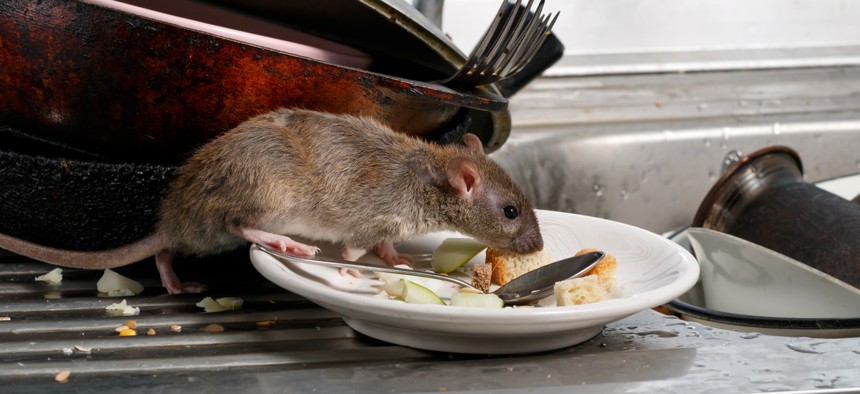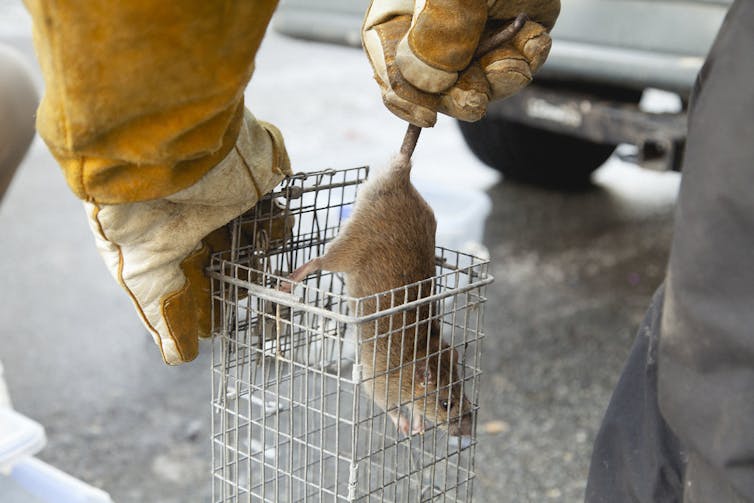It’s Surprisingly Hard to Find Out How Rats Move Through Cities

Rats are infamous for travelling with us across the globe and yet, until recently, there was very little information on how rats move within cities. Shutterstock

Connecting state and local government leaders
COMMENTARY | To address rodent-related concerns, it’s useful to know how rats travel. Genetic testing might hold some answers.
It’s dark and I’m parked in an alley near a lopsided compost bin. I have a notepad, binoculars and a lukewarm cup of coffee — everything needed for a successful stakeout. I am waiting for them.
They appear approximately one hour before dawn, skittering from dumpster to dumpster along old paths they have worn down with time. I am trying to track their movements, to understand how far they go and how often. But it’s clear to me that the traditional detective approach isn’t going to work. There are too many and they move in places where I can’t follow. I’ll have to track them a different way — I’m going to need some rat DNA.
Take a trip to a city almost anywhere in the world and odds are that you will find rats. Rats are infamous for travelling with us across the globe and yet, until recently, there was very little information on how rats move within cities.
Slippery Little Fellas
As someone who has trapped more than 700 rats, I can tell you that this lack of information is partly because rats are notoriously difficult to study. For other wildlife species, you can track movement by trapping an animal, tagging it with something like a numbered ear tag, recapturing that animal later on and then measuring the distance between traps. But rats are wary of traps, and very few rats will re-enter them more than once.
To get around issues of trappability, researchers can use GPS technologies. This approach still involves wrangling rats to affix GPS tags, but advances in GPS technologies allow for data to be transmitted to the researcher remotely without having to catch the animal again. In fact, miniaturization of tags has allowed us to attach GPS tags to rats. But we’ve learned that GPS tags are tricky to use with urban rats because they will remove them and satellite signals are obstructed in cities. Thank you, next?

An alternative to these approaches involves collecting rat DNA. Chances are you’ve heard of companies like 23andMe that track your global ancestry by sequencing DNA from your saliva. This approach looks at similarities and differences in the genetic codes of individuals to make inferences about how similar your DNA sequence is to that of other people in the database. This can also be applied to rats. Indeed, researchers have used genetics to track the migration of rats globally. But how can this information help us to understand and address rat-associated issues?
Staying Close to Home
When sampled across a city, we can trace rat movement at a finer scale. Over the past 10 years, there has been an increase in the number of rat movement studies using genetics. By looking at relatedness of individuals based on genetic similarity, we can identify groups of relatives. We’ve found that relatives are often in close proximity to each other.
In Vancouver, most relatives are within approximately 50 metres of each other and relatedness tends to decrease past 250 metres; on the whole, rats probably don’t move very far.
However, some rats travel further afield. In Baltimore, one rat was estimated to have moved up to 11.5 kilometres. These migrant individuals can be identified because their genetic information assigns them to a group of individuals in a different location than to the one in which they were caught.
Thanks to genetics, we have come to understand that while rats typically move about the space of a city block, they move further than was estimated by observational methods. This is useful to know because it can help inform how we address rat-associated concerns.
Pathogens on the Block
Rats carry a number of disease-causing organisms that can be transmitted to people. Many of these are spread among rats and to people through close contact with affected rats and their urine or feces. In Vancouver, where rats rarely move between blocks, we would expect that the pathogens they carry would be restricted as well, due to few opportunities to spread.
And that’s what we see. Some blocks have many rats carrying a particular pathogen, while a neighbouring block may have few or no affected rats. This is important because it suggests that actions that disrupt the normal patterns of rat movement could affect pathogen spread.
To remove rat-associated disease risks, efforts have focused on eliminating rats altogether, but this approach has been largely ineffective. This is partly because we fail to appropriately scale our control response.
Most control efforts are enacted at a single property. If we look to the DNA, however, we see why that approach won’t cut it. Rats and rat colonies are often not restricted to a single property. For control efforts to be effective, they must encompass the genetic group, termed an eradication unit.
The scale of the unit varies by location due in part to barriers to movement such as roadways or rivers. For example, in Vancouver a genetic cluster of related rats occupies an entire block, or spans several blocks. By comparison, researchers have found that an eradication unit might encompass an entire “valley” in Salvador, Brazil.
From my vantage point in the alley, I am struck by the power of genetic sequencing to help us answer challenging questions. Instead of viewing each rat independently, I begin to see them as interconnected groups of relatives scurrying along the pavement. I wonder if any are outsiders, migrants from another block.
I check my bag and realize that something’s missing. Tomorrow I’ll be back with what I need for DNA collection: my Rat Detective Toolkit 2.0.
This article is republished from The Conversation under a Creative Commons license. Read the original article.
Kaylee Byers is the regional deputy director at the British Columbia Node of the Canadian Wildlife Health Cooperative.

NEXT STORY: A City Council Bans Construction of New Drive-Thrus




